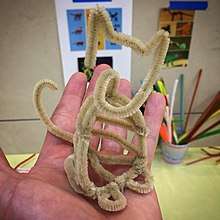Pipe cleaner
A pipe cleaner or chenille stem is a type of brush originally intended for removing moisture and residue from smoking pipes. Besides cleaning pipes, they can be used for any application that calls for cleaning out small bores or tight places. Special pipe cleaners are manufactured specifically for cleaning out medical apparatus and for engineering applications. They are popular for winding around bottle necks to catch drips, bundling things together, colour-coding, and applying paints, oils, solvents, greases, and similar substances. They can also be used like a twist tie.


Description
Smoking pipe cleaners normally use some absorbent material, usually cotton or sometimes viscose. Bristles of stiffer material, normally monofilament nylon or polypropylene are sometimes added to better scrub out what is being cleaned. Microfilament polyester is used in some technical pipe cleaners because polyester wicks liquid away rather than absorbing it as cotton does. Some smoking pipe cleaners are made conical or tapered so that one end is thick and one end thin. The thin end is for cleaning the small bore of the pipe stem and then the thick end for the bowl or the wider part of the stem. When used for cleaning purposes, pipe cleaners are normally discarded after one or two uses.
Crafts
Pipe cleaners are commonly used in arts and crafts projects. "Craft" pipe cleaners are usually made with polyester or nylon pile and are often longer and thicker than the "cleaning" type, and available in many different colors. Craft pipe cleaners are not very useful for cleaning purposes, because the polyester does not absorb liquids, and the thicker versions may not even fit down the stem of a normal pipe or into the usual hard-to-access area of applications that call for cleaning small bores or tight places. In Japan, crafting with pipe cleaners is known as Mogol art. Its name derived from the Portuguese word Mughal for a style of weaving.[1] Workshops in malls and schools in Japan have been led by Atushi Kitanaka on an effort to support the pipe cleaner industry. Ikuyo Fujita(藤田育代 Fujita Ikuyo)is a Japanese artist who works primarily in needle felt painting and mogol (pipe cleaner) art. Use of pipe cleaners as an art format where animals [2] are made by twisting pipe cleaners together. They can also be used to create whiskers for an animal mask or nose.
Manufacture
A pipe cleaner is made of two lengths of wire, called the core, twisted together trapping short lengths of fibre between them, called the pile. Pipe cleaners are usually made two at a time, as the inner wires of each pipe cleaner have the yarn wrapped around them, making a coil, the outer wires trap the wraps of yarn, which are then cut, making the tufts. Chenille yarn is made in much the same way, which is why craft pipe cleaners are often called "chenille stems". The word chenille comes from French meaning caterpillar. Some pipe cleaner machines are actually converted chenille machines. Some machines produce very long pipe cleaners which are wound onto spools. The spools may be sold as-is or cut to length depending on the intended use. Other machines cut the pipe cleaners to length as they come off the machines. Smoking pipe cleaners are usually 15–17 cm (6–7 inches) long. Craft ones are often 30 cm (12 inches) and can be up to 50 cm (20 inches).The diameter comes in 4 mm; 6 mm; and 15 mm sizes[3] Jumbo pipe cleaners have a 30 mm diameter with lengths of 18 inches and 6.5 feet.
References
| Wikimedia Commons has media related to Pipe cleaners. |